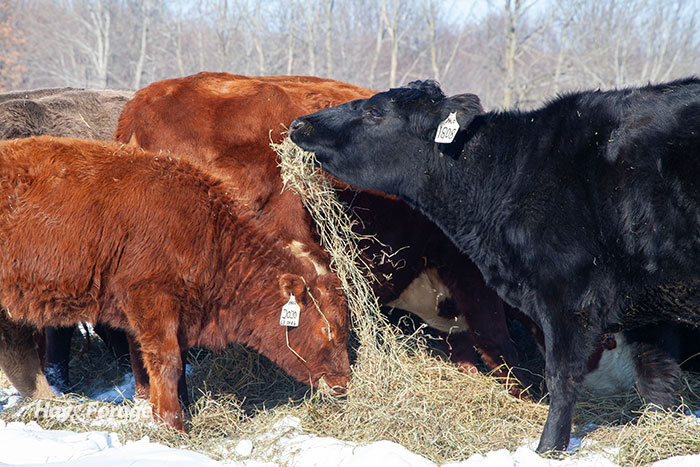
Controlling hay waste is a top priority for beef producers, but it should not come at the cost of animal intake or body condition. These factors can affect one another and must be monitored throughout the winter to ensure farms are profitable and cows stay healthy.
Zac Carlson with North Dakota State University explains how different practices can influence forage intake, and thus hay waste, in an article from the Midwest Forage Association’s Forage Focus newsletter. The extension beef cattle specialist says maximizing feed efficiency and minimizing hay waste is key to combat commodity market uncertainty.
To compare feeding methods, Carlson refers to a University of Minnesota study that shows hay waste in an open bottom ring feeder was about 7%, while cattle wasted approximately 18% of hay when bales were processed and windrowed or rolled out on the ground. Nonetheless, cows in both treatments consumed similar amounts of hay on a dry matter basis.
Another study from North Dakota State University dissected the two approaches to feeding hay on the ground. Researchers found cows consumed 1.5 more pounds of hay per day when bales were processed and windrowed rather than when bales were rolled out. This translated to a 16-pound gain per animal over a 59-day period.
“Of course, processing and windrowing bales came at an additional cost compared to rolling out bales,” Carlson writes. “Perhaps in certain scenarios, you may want to increase intake, making the added expense potentially worthwhile.”
Research from Oklahoma State University shows animal intake was relatively the same among different types of hay feeders, yet the amount of hay waste varied. For example, cows using a tapered cone hay ring wasted about 5% of forage, whereas those using a conventional closed bottom hay ring wasted nearly 12%.
Less may be more
Limit feeding might be a solution to simultaneously reduce hay waste and manage animal intake. Carlson states that cows can maintain body weight and body condition even though limit feeding can lower hay consumption up to 25%. This is because a lower feed intake will slow forage passage rate in the rumen, which could enhance its digestibility.
Data from a University of Minnesota study shows cows wasted less than 1% of hay and consumed 29% less forage when they only had access to feed for six hours instead of 24 hours. Cattle also maintained their body weight throughout the experiment.
With that said, cows must start out with a healthy body condition, and hay must be high quality for limit feeding to be successful. Carlson adds some animals will be more aggressive than others with limited access to feed, so sufficient space is required.
“Farmers need to ensure the feeding area is large enough so all cows have access to hay,” he asserts. “Limiting physical access and restricting time may leave the timid or weak cows without a meal.”
Monensin elevates energy
In addition to regulating hay consumption and waste, providing monensin could help optimize winter feeding. Monensin is an ionophore, which is a type of antibiotic that alters rumen microbial populations to improve the energetic efficiency of forage. Carlson notes supplementing hay with monensin could boost the amount of available energy in a cow’s diet up to 5%.
Carlson recommends feeding 50 to 200 milligrams (mg) of monensin per animal per day with at least 1 pound of feed. He refers to a summary of 26 studies that shows cows fed monensin maintained body weight and body condition even though feed intake dropped by roughly 8%. To be sure, producers must provide supplemented hay every day so it is effective for the entire herd.

